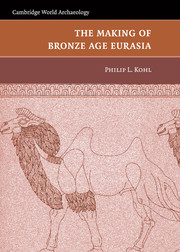Book contents
- Frontmatter
- Contents
- Illustrations and Maps
- Abbreviations
- Preface
- Frontispiece: Eurasian Steppe Zone and the Greater Ancient Near East
- 1 Archaeological Theory and Archaeological Evidence
- 2 The Chalcolithic Prelude – From Social Hierarchies and Giant Settlements to the Emergence of Mobile Economies, ca. 4500–3500 BC
- 3 The Caucasus – Donor and Recipient of Materials, Technologies, and Peoples to and from the Ancient Near East
- 4 Taming the Steppe – The Development of Mobile Economies: From Cattle Herders with Wagons to Horseback Riders Tending Mixed Herds; the Continued Eastward Expansion of Large-Scale Metallurgical Production and Exchange
- 5 Entering a Sown World of Irrigation Agriculture – From the Steppes to Central Asia and Beyond: Processes of Movement, Assimilation, and Transformation into the “Civilized” World East of Sumer
- 6 The Circulation of Peoples and Materials – Evolution, Devolution, and Recurrent Social Formations on the Eurasian Steppes and in West Asia: Patterns and Processes of Interconnection during Later Prehistory
- Appendix
- References
- Index
3 - The Caucasus – Donor and Recipient of Materials, Technologies, and Peoples to and from the Ancient Near East
Published online by Cambridge University Press: 05 June 2012
- Frontmatter
- Contents
- Illustrations and Maps
- Abbreviations
- Preface
- Frontispiece: Eurasian Steppe Zone and the Greater Ancient Near East
- 1 Archaeological Theory and Archaeological Evidence
- 2 The Chalcolithic Prelude – From Social Hierarchies and Giant Settlements to the Emergence of Mobile Economies, ca. 4500–3500 BC
- 3 The Caucasus – Donor and Recipient of Materials, Technologies, and Peoples to and from the Ancient Near East
- 4 Taming the Steppe – The Development of Mobile Economies: From Cattle Herders with Wagons to Horseback Riders Tending Mixed Herds; the Continued Eastward Expansion of Large-Scale Metallurgical Production and Exchange
- 5 Entering a Sown World of Irrigation Agriculture – From the Steppes to Central Asia and Beyond: Processes of Movement, Assimilation, and Transformation into the “Civilized” World East of Sumer
- 6 The Circulation of Peoples and Materials – Evolution, Devolution, and Recurrent Social Formations on the Eurasian Steppes and in West Asia: Patterns and Processes of Interconnection during Later Prehistory
- Appendix
- References
- Index
Summary
Issledovateli arkhaichnogo obmena na dalekie rasstoyaniya neodnokratno obrashchali vnimanie na to, shto ego ob'ektami vystupali ne predmety pervoi neobkhodimosti, a roskoshnye i prestizhnye veshchi. Stremlenie obladat' imi sluzhilo intensifikatsii proizvodstva, polucheniyu vse bol'shikh izlishkov…. Hesomnenno, obmen okazyval bol'shoe vliyanie na obshchestvo gortsev, stimuliruya dobychu i pervichnuyu obrabotku metallov, shto trebovalo organizatsii proizvostva i neminuemo velo k uslozhneniyu sotsial'noi strukturi
[Investigators of long-distance exchange frequently have observed that the objects exchanged were not in the first instance necessities, but luxuries and prestige items. The desire to obtain them led to the intensification of production and the acquisition of large surpluses…. Undoubtedly, exchange exerted great influence on the society of the mountain peoples, and stimulated the extraction and initial working of metals, tasks that demanded an organization of production and inevitably led to a more complex social structure].
(Avilova, Antonova, and Teneishvili 1999: 61, 64)The Copper Age of the Caucasus – or, more precisely, the immediately pre-Maikop and pre-Kura-Araxes horizons of the northern and southern Caucasus, respectively – appears remarkably impoverished relative to the spectacular Chalcolithic developments considered in the previous chapter. Nothing comparable to the Cucuteni-Tripol'ye complexes exists in the Caucasus during the sixth through the first half of the fourth millennium BC; even more striking is the underdevelopment of the northern Caucasus before the emergence of the famous Maikop culture, which most specialists (Munchaev 1994: 169–170) now date as beginning at least towards the second half of the fourth millennium, if not somewhat earlier (Trifonov 1996, 2001; Lyonnet 2000, n.d.c.; Chernykh and Orlovskaya 2004a; cf. later discussion).
- Type
- Chapter
- Information
- The Making of Bronze Age Eurasia , pp. 57 - 125Publisher: Cambridge University PressPrint publication year: 2007



